This Lesser-known Region of Italy Has Stunning Ocean Views, 3 National Parks, and Rolling Vineyards — and It's Outside of Rome
Abruzzo is filled with dazzling medieval towns, rolling vineyards, and a divine food scene.

Gabriele Paris/Getty Images
Some 130 miles away from Rome in central Italy is a region that offers travelers a world of opportunity: Abruzzo. It's filled with dazzling medieval towns, rolling vineyards, pictorial stretches of sand on the Adriatic Coast, and alpine peaks set amongst three protected national parks. It's home to 75 percent of all European animal species, flora, and fauna. In fact, it's so lush that it's often called the "green lung of Europe."
Having visited Tuscany’s famed vineyards years ago, I was excited to see what this less frequented part of central Italy had to offer, from its celebrated Montepulciano wines to its charming towns flanked by mountains and the sea. Abruzzo has four provinces: Chieti, Teramo, L’Aquila, and Pescara. I called Chieti — a hilltop town dotted with ancient streets and a coastline filled with sunbathers and fishing huts — home.
It's easy to reach Abruzzo from international airports like Rome’s Leonardo da Vinci–Fiumicino Airport (FCO) or Bologna Guglielmo Marconi Airport (BLQ). Some connections are also offered through Abruzzo Airport (PSR). The Adriatic coastline is connected through high-speed railway services; the trip from Bologna Centrale to Pescara Central in Abruzzo takes a little over three hours.
I made my way to Chieti after spending a few days in Rome's Sofitel Rome Villa Borghese, a former 19th-century palazzo. I opted for a curated experience — created by Sofitel Rome Villa Borghese and Masciarelli Winery — that mixes city and sea, called 10-night Italy: City and Coast Getaway. It features a full itinerary in both Rome and Abruzzo and includes private, round-trip transportation.
The three-hour journey to Abruzzo took me past scenic vineyards and cliff-clinging villages. Upon arrival, what immediately stood out to me was the lack of crowds — it was an entirely different vibe than Rome. Here's what my experience was like.
Where I Stayed
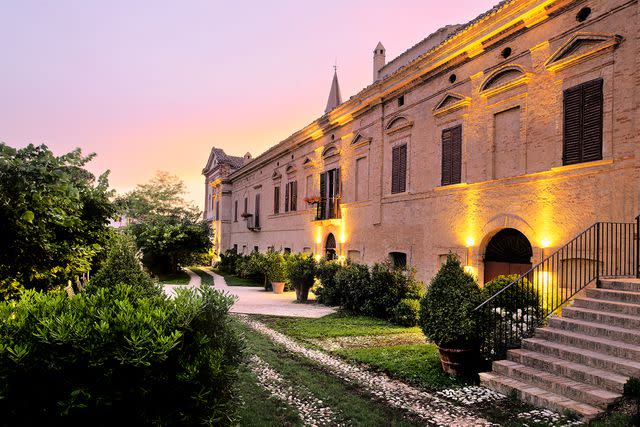
Courtesy of Castello di Semivicoli
I checked into Castello di Semivicoli, an 11-room, 17th-century castle surrounded by vineyards and mountain peaks that frame the sparkling Adriatic Sea. But really, I was here for the wine — the idyllic location and views were just the bonus.
The three-generation Masciarelli name is well-known in the region as the driving force for putting Abruzzo wines (like Montepulciano d'Abruzzo and Trebbiano) on the map, helmed by Gianni Masciarelli. (In 2004, Masciarelli and his wife Marina Cvetic purchased Castello di Semivicoli, keeping its historical details intact, including an olive press, antique furniture, and Murano glass chandeliers.)
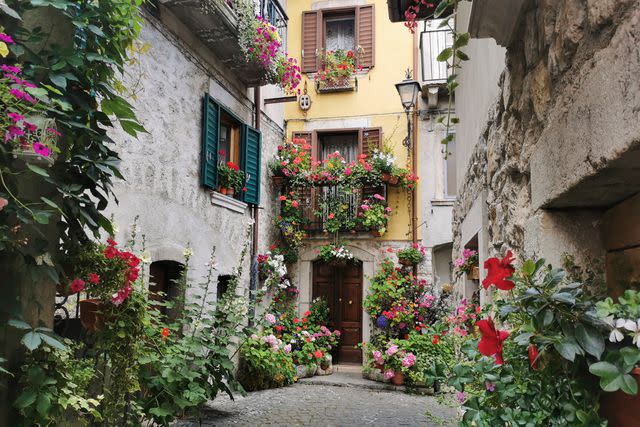
tanukiphoto/Getty Images
I spent my afternoons poolside, sipping the first Masciarelli varietal (the black fruit-driven Villa Gemma) and Cerasuolo, a zippy cherry forward rosé. Guests at Masciarelli can also take cooking lessons, a private vineyard tour, and visit former professional soccer player turned winemaker Luigi Valori’s organic vineyard in northern Abruzzo.
What I Ate
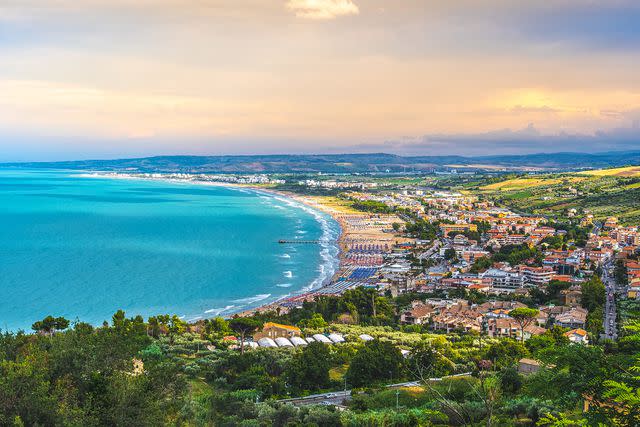
LucaLorenzelli/Getty Images
The pastoral and coastal location of Abruzzo makes for a diverse cuisine of seafood, legumes, and meats ranging from mutton to pork. Thinly salted mutton skewers, called arrosticini, are one of the region’s most popular.
Don’t miss a visit to a sagre (local fair), for a chance to try ventricina (hot spicy salami), artichokes, and freshly baked bread.
Abruzzo has produced handmade spaghetti alla chitarra for more than 200 years. It's often served with a tomato sauce made with miniature meatballs, called sugo di pallottine.
A popular seafood dish is brodetto alla pescarese, which is a stew made of slow-cooked tomatoes, pepperoncini, garlic, and small fish ranging from mullet to skate wings.
For sweet tooth satiation, two well-known desserts of the region include sugar-coated almonds (called confetti), and a soft chocolate nougat from L’Aquila, called torrone nurzia.
What to Do
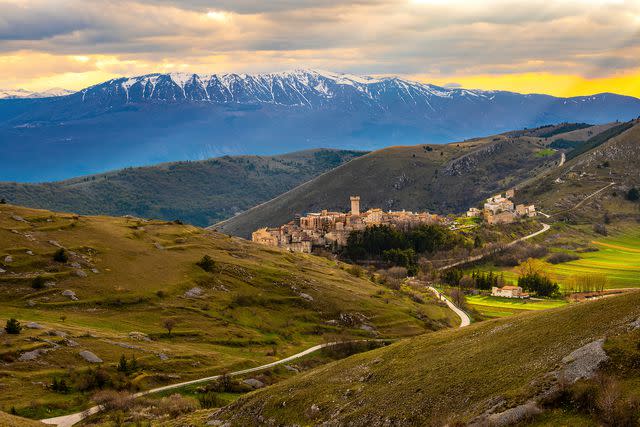
LucaLorenzelli/Getty Images
Outdoor enthusiasts will find several activities in Abruzzo. In the medieval mountain hamlet of Castel del Monte sits Gran Sasso National Park, a biodiverse playground accessible for children, elderly people, and visitors with mobility limitations. Marked as a protected area since 1995, the park is filled with olive groves, almond trees, and areas dedicated to mountain biking and horseback riding. Campo Imperatore plateau, often called Abruzzo’s "Little Tibet" because of its comparable Himalayan views, is also in Gran Sasso and accessible year-round.
Along the coast, a 26-mile back path called Via Verde leads to the Trabocchi coast, where fisherman huts on water stilts line the sea like wooden octopus’ in the distance. A dinner of grilled seafood paired with Vini Valori wines at Trabocco Valle Grotte, suspended over the water during a multi-colored sunset, remains one of the greatest moments of my trip.
Also along the Trabocchi coastline, Punta Aderci Nature Reserve is a protected enclave of dunes, beaches, and clifftops where you can bike along a path or grab a seat on its pebbly sand.
The Wines of Abruzzo
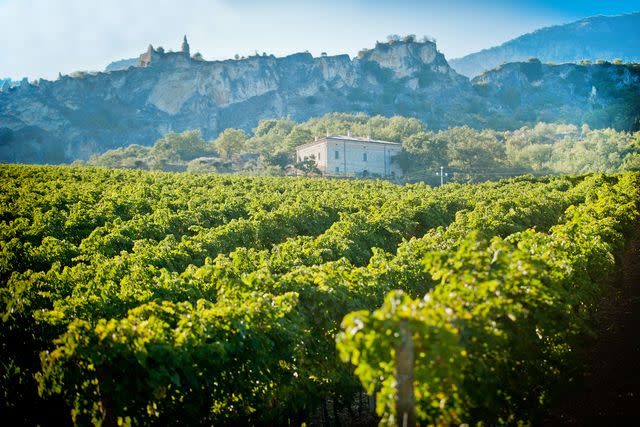
Courtesy of Pasetti Winery
Never one to shy away from a wine tasting or two, I eagerly leaned into learning more about Abruzzo’s varietals. After all, its proximity to the sea and the Apennine Mountains creates an ideal Mediterranean climate for growing wine, and there are approximately 250 wineries in the region that produce roughly 1.2 million bottles per year.
I was off to a good start in Chieti, as the area produces the majority of wines in Abruzzo, including the coveted DOC label, which notes the highest level of quality assurance. While Tuscany is well known for its Vino Sangiovese grape used to make its Vino Nobile di Montepulciano, in Abruzzo, it’s all about the full-bodied Montepulciano grape. (Montepulciani d’Abruzzo represents approximately 80 percent of the region’s wine, followed by Trebbiano d'Abruzzo, Pecorino, and Cerasuolo–an Abruzzo rosé.)
At Masciarelli, visitors can tour the barrel rooms and then have a curated tasting at Castello di Semivicoli, paired with typical Abbruzzese food. The region’s dry and herbal white wine, Trebbiano, is a good complement to the fragrant seafood stews and fried foods of the region.
Fifth-generation Pasetti Winery and guest home is elevated 1,800 feet above sea level in the village of Pescosansonesco, inside the National Park of Gran Sasso and Monti della Laga. It’s an ideal location to spend a day immersed in nature and several varietals. Their Pecorino is filled with aromas of grapefruit and pairs well with just about any seafood dish.
To learn more about Abruzzo, visit italia.it and to learn more about the package, visit all.acor.com.
For more Travel & Leisure news, make sure to sign up for our newsletter!
Read the original article on Travel & Leisure.


